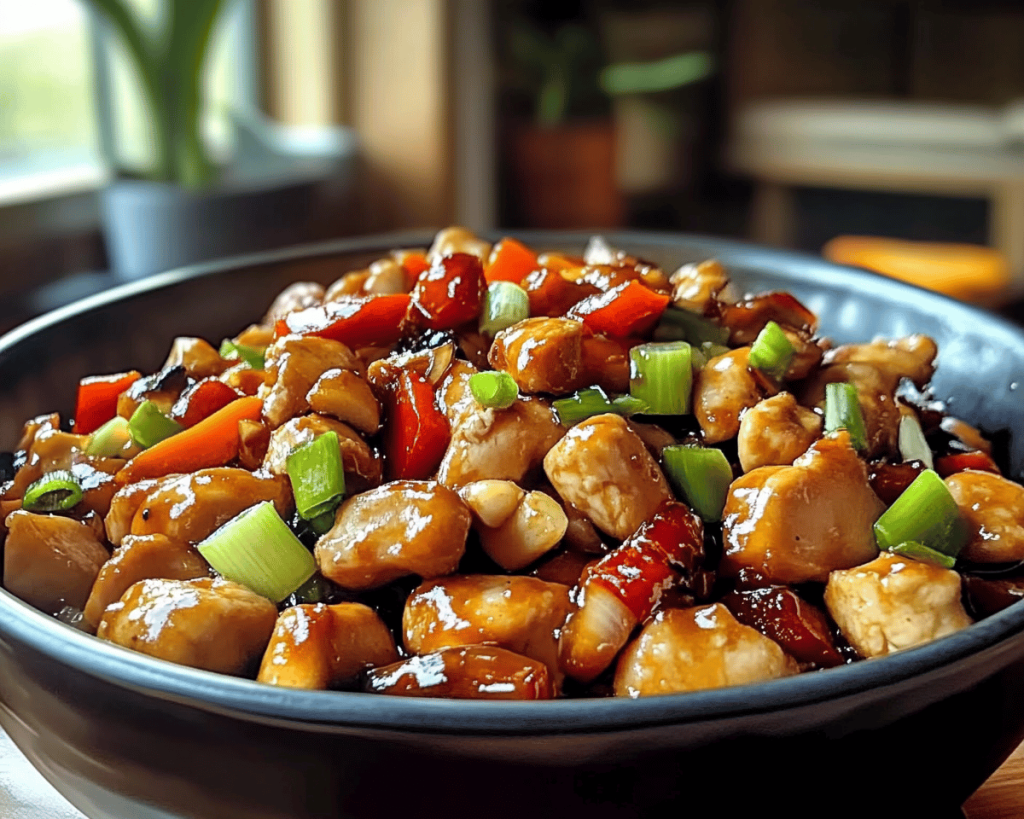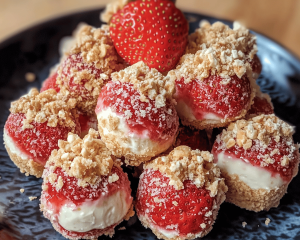The very first time I made Kung Pao Chicken, it was a cold, blustery evening in late autumn, one of those nights where the wind howled like a hungry ghost, and the smell of impending winter loomed just outside my kitchen window. I remember standing in my tiny apartment kitchen, the kind where you can grill a cheese sandwich while reaching into the fridge — a bustling student life aesthetic. I was armed with a colorful, dog-eared cookbook that had long since stained the pages with the remnants of meals past.
Despite being drawn in by the energetic illustrations and knowing smiles from the various chefs pictured, I was mostly lured by the enticing promise of Kung Pao Chicken: tender, stir-fried chicken with a savory-sweet sauce, crunchy peanuts, and a bold kick of spice. It danced in my imagination, the treasured flavors from the corner Chinese take-out that I had indulged in during my college years. That evening felt monumental; I wanted to capture the comfort of those cozy take-out boxes filled with irresistible flavors—yet my rendition would be home-cooked and personal.
As I chopped garlic, my knife woefully inadequate against the stiff chicken breast I’d picked up at my local market, I found unexpected solace. The sharp scent of garlic wafting through the air felt like an embrace, while the sizzle in the pan promised warmth and satisfaction. The soy sauce, with its deep umami note, invited me into the aromatic landscape of culinary exploration. And when the peanuts finally joined the party—a nutty crunch from my childhood snacks—I felt like I had conjured something magical.
What I didn’t realize at the time was that Kung Pao Chicken would become far more than just a recipe; it would become a canvas for learning, sharing, and community. Over the years, I’ve made this dish countless times, with fluctuating results, of course. I revisited childhood memories and friendships, the joy of laughter over steaming bowls, and sometimes the trials of cooking for picky eaters. Alongside mishaps where I mistook tablespoons for teaspoons—that spicy disaster burned the taste buds off my best friend once—I discovered how this simple dish could transform into something deeply satisfying, all while reminding me of its vibrant story.
Today, Kung Pao Chicken is a beloved staple of my kitchen, serving as a reminder of where I’ve been and the connections that matter most—a comfort food that brings the heart of everyday moments into focus.
Inside the Ingredients of Authentic Kung Pao Chicken
Let’s wander through the flavors and textures of Kung Pao Chicken together, step by step, ingredient by ingredient.
Chicken: It’s the heart of the dish. Typically, I use tender boneless, skinless chicken thighs. They are more flavorful than breasts and hold up beautifully during stir-frying. In moments of craving, I’ve switched this out for tofu or seitan for a plant-based version, and it absolutely works. There’s something profoundly satisfying about letting the ingredients speak for themselves while still making allowances for personal tastes.
Peanuts: These crunchy nuggets are not just for texture; they’re integral to the dish’s identity. Peanuts evoke childhood snack memories for me, as they do for many. Their saltiness and rich, nutty flavor harmonize beautifully with the sauce, lending balance to the heat and acidity. Whenever I make this dish, I can’t help but sneak a handful of roasted peanuts as I cook.
Scallions: These slender green allies lend brightness, both visually and flavor-wise. Their mild onion flavor is a perfect counterpart to the richer elements in Kung Pao Chicken, cutting through the intensity without overwhelming. The bright green color gives it that burst of freshness that not only beautifies the dish but also brings a little cheer to the plate.
Garlic and Ginger: These aromatic partners really elevate the dish. I can’t think about Kung Pao Chicken without recalling those moments of finely mincing garlic and ginger—my trusted friends in flavor-building. The pungent warmth of ginger mingles with the cutting force of garlic to create a fragrant base that’s hard to resist.
Szechuan Peppercorns: What truly sets Kung Pao apart from other stir-fries is the unique punch of Szechuan peppercorns. They have a distinct floral, citrusy taste that creates a numbing sensation—a signature of Szechuan cuisine. They might feel foreign at first, but trust me, they introduce a sensation that brings the dish to life and transports you straight to a bustling Chengdu market.
Soy Sauce: This humble ingredient is the backbone of the dish’s savory flavor. Both light and dark soy sauce play a role: the light for saltiness and the dark for richness. Together, they create a well-rounded base. I often remind myself that the best soy sauce can elevate a meal from mundane to extraordinary, making it worthwhile to invest in quality.
Rice Vinegar: A touch of acidity to balance out the richness is non-negotiable. I reach for unseasoned rice vinegar, as its light flavor brightens up the dish and allows all the other flavors to shine. Just a splash is enough to tie everything together beautifully; it’s akin to the whisper of wisdom in an old friend’s story.
Brown Sugar: Sweetness is imperative for a Kung Pao sauce. I prefer brown sugar, as it brings a slight molasses depth and warmth. But don’t be fooled, it’s an intricate dance of flavors—you need just enough sweetness to balance the savory and spicy notes without tipping the scales too far in any direction.
How Kung Pao Chicken Fits Into a Balanced Life
Life has a funny way of leading us to moments of profound reflection, especially in the kitchen. Kung Pao Chicken is one of those recipes that stands as a testament to balance—not just in taste but in life itself.
As I work on perfecting the dish, I think about how cooking helps us slow down, to digest not just our food, but our experiences. Preparing Kung Pao Chicken asks for my full attention; it’s vibrant, it’s chaotic, and occasionally it’s messy. But with each stir of the spatula, I remind myself to be kind to my kitchen—much like I strive to be kind to myself and others.
From a nutritional perspective, this dish allows for interpretations and substitutions. With plenty of colorful veggies added, it can easily morph into a more balanced meal. Crunchy bell peppers, snap peas, or thinly sliced carrots can join the mix—making it a delightful rainbow on my plate. Make it gluten-free with tamari or offer a low-carb version by skipping rice and substituting with cauliflower rice.
Yet, here’s the crux: as much as we chase the notion of health, it’s equally vital to embrace joy without guilt. Sure, Kung Pao Chicken may not be the lightest dish, but every bite is a celebration of textures, flavors, and memories. During tough days or moments of doubt, I find comfort in this dish, knowing I can always create a plate that feels like home.
What You’ll Need
– 2 tablespoons vegetable oil
– 1 pound boneless, skinless chicken thighs, cut into bite-sized pieces
– 1/2 cup roasted unsalted peanuts
– 3 green onions, sliced (whites and greens separated)
– 3 cloves garlic, minced
– 1 tablespoon fresh ginger, minced
– 1 teaspoon Szechuan peppercorns
– 1/4 cup light soy sauce
– 2 tablespoons dark soy sauce
– 1 tablespoon rice vinegar
– 1 tablespoon brown sugar
– 1 tablespoon cornstarch, mixed with 2 tablespoons water to create a slurry
– Cooked rice for serving
This recipe can serve 4 people generously.
Preparing Kung Pao Chicken Step by Step
Now, let’s roll up our sleeves and dive into the glorious process of making Kung Pao Chicken.
First things first, heat the vegetable oil in a large skillet over medium-high heat. Take a moment to appreciate how the oil shimmers, ready to dance with your ingredients. This is where the magic begins.
Once hot, add the chicken, stirring to sear each piece, allowing it to develop a slight char. Don’t rush this step—let it sizzle enticingly. About 5-7 minutes should do the trick; set aside the tender chicken when it’s golden brown.
In the same skillet, toss in the ginger and garlic—like invited friends showing up to a party, they’ll start releasing their fragrance immediately, so don’t get distracted! Stir them for only about 30 seconds until they become fragrant—watch they don’t burn!
Next, toss in the Szechuan peppercorns and the whites of the scallions, allowing them to mingle and infuse their fiery exclusivity into the mix. This sounds chaotic, but trust me, it will fondly greet your palate later.
Add the chicken back into the pan, followed by the light soy sauce, dark soy sauce, brown sugar, and rice vinegar. The mixture will bubble and froth, creating an enticing aroma that could lure anyone into the kitchen. Taste a spoonful to find the balance: tweak the sugar or soy sauce to your liking.
As a final touch, introduce the cornstarch slurry. Watch it thicken before your very eyes. This slow transformation is a beautiful metaphor for how everything can come together if we only give it a little time and care.
Lastly, fold in the peanuts and the green tops of the scallions. Let them play for just a minute, absorbing the sauce and becoming part of the culinary family.
When everything is combined, serve your glorious Kung Pao Chicken over a fluffy mound of cooked rice—both grounding and elevating this delight. Take a moment to enjoy the colors, the smell, and perhaps snap a photo before it vanishes into delicious oblivion.
Lessons from My Kitchen
Through the years of cooking Kung Pao Chicken, I have encountered numerous lessons—a collection of growth worth sharing.
Mistakes are inevitable; like the time I accidentally added salt instead of sugar. The panic was palpable, yet with creativity and a little extra vinegar, I managed to salvage the dish. Mistakes, I’ve learned, don’t mean failure—they can lead to fiery explosions of new flavors.
I’ve also experimented with seasonal variations, adding snow peas in the spring and honeyed carrots in late summer, embracing the beauty of what the seasons give. Each version tells a new story, capturing different moments in time—recipes transform and breathe with life. Not to forget the diverse palates of family and friends. While some enjoy a heartier spice, others prefer a milder experience. Flexibility in the kitchen is an art, and it has enriched not only my cooking but my relationships.
“Cooking is an act of love,” my grandmother used to say, and those words resonate with me. Food transcends the physical—it’s a conduit for connection. In every vegetable I slice and every chicken piece I sear, I carry those lessons into my kitchen.
I envision a world where sharing recipes is another way of sharing stories, a reminder that even in our culinary ambitions, we are not so different from one another. The simple act of cooking Kung Pao Chicken deepens my appreciation for flavors, friends, and family.
(Closing Thought)
As I conclude my reverie over Kung Pao Chicken, I find myself laughing at the imperfections and the glorious messiness of it all. This is more than a recipe; it’s a tapestry of life, stitched together with the threads of memories, laughter, and warmth. I encourage you to step into your kitchen and mold this dish to your liking. Embrace its flavors, share its joys, and with every bite, let it remind you of the connections that flavor your own life.
Just remember: after all the chopping, stirring, and seasoning, it’s not just about the food. It’s about the moments you create around your dining table, the stories told with the clinking of plates, and the love that fills the air. Happy cooking!



